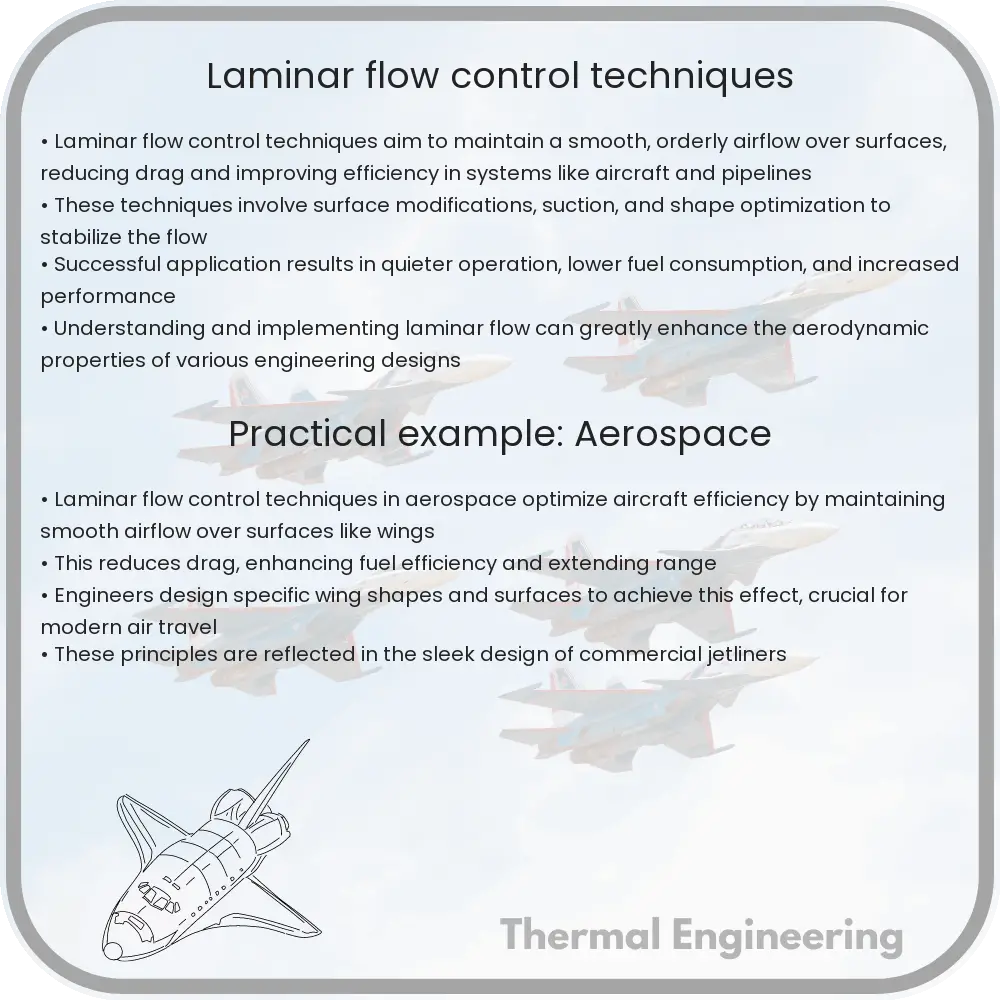Learn about Laminar Flow Control Techniques, crucial for enhancing efficiency and reducing drag in aerospace and marine vehicles.

Laminar Flow Control Techniques
Laminar flow control techniques are essential for reducing skin friction drag on aircraft and marine vehicles, improving their efficiency and performance. By maintaining the flow of air or water close to the surface of a vehicle in a smooth and orderly layer, these techniques can significantly reduce the energy expenditures and increase operational efficiency.
Understanding Laminar Flow
Laminar flow occurs when a fluid flows in parallel layers, with no disruption between the layers. This type of flow is characterized by smooth streamlines and minimal mixing. The opposite of laminar flow is turbulent flow, which involves chaotic changes in pressure and flow velocity.
Techniques for Laminar Flow Control
- Surface Shape and Smoothness: The shape and smoothness of a surface significantly influence whether the flow over it remains laminar. Aircraft and ships often feature carefully designed, smooth shapes to maintain laminar flow across key areas.
- Suction: One effective method for controlling laminar flow is to use suction through the surface. Small perforations or slots are created in the surface through which air is sucked out, helping to stabilize the boundary layer and delay the transition to turbulence.
- Blowing: Similarly to suction, blowing involves introducing a small amount of air at specific points along the surface to influence the boundary layer’s stability and maintain laminar flow.
- Vortex Generators: Small, blade-like devices called vortex generators can be installed on surfaces to create tiny vortices in the airstream. This helps in managing the boundary layer and prolonging the region of laminar flow.
- Compliance: Making the surface partially compliant can also help in maintaining laminar flow. The surface can adapt to oncoming flow variations, which helps in delaying the onset of turbulence.
Mathematical Representation of Laminar Flow
The behavior of laminar flow can be described using the Navier-Stokes equations, which are a set of equations that describe the motion of viscous fluid substances. The simplified form of the Navier-Stokes equation for incompressible flow, assuming steady state and ignoring external forces, is:
\[ \nabla \cdot \vec{u} = 0 \]
And,
\[ \rho (\vec{u} \cdot \nabla) \vec{u} = -\nabla p + \mu \nabla^2 \vec{u} \]
where \( \vec{u} \) is the velocity field, \( p \) denotes the pressure, \( \rho \) is the fluid density, and \( \mu \) represents the dynamic viscosity of the fluid.
Applications and Benefits
The application of laminar flow control techniques extends across various fields. In aerospace, maintaining laminar flow over wings and fuselage surfaces can significantly reduce drag, leading to fuel savings and increased range. In the maritime industry, such techniques can reduce resistance experienced by ships, translating to higher speeds and lower fuel consumption. Furthermore, laminar flow is also pivotal in various industrial processes that require precise control of fluid dynamics, such as in coating and the manufacture of composite materials.
By understanding and applying laminar flow control techniques, engineers can design more efficient, cost-effective, and environmentally friendly vehicles and systems, which are crucial attributes in our increasingly energy-conscious world.